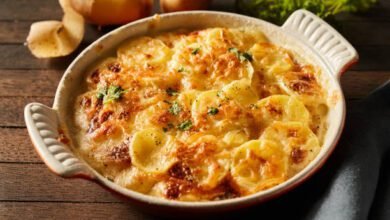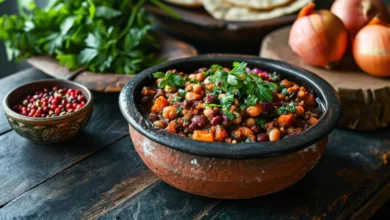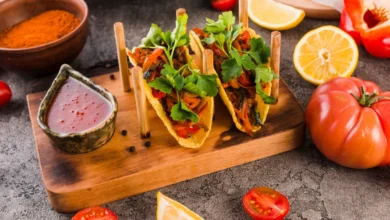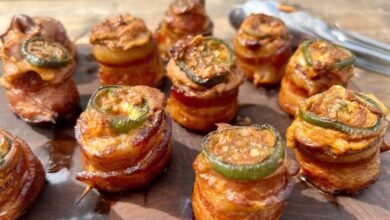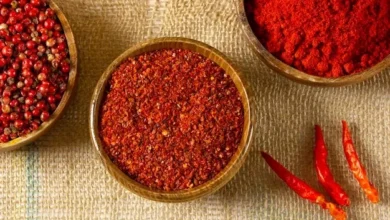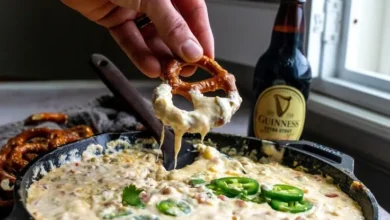How to Smoke a 15 Pound Brisket: Savoring Smoky Success
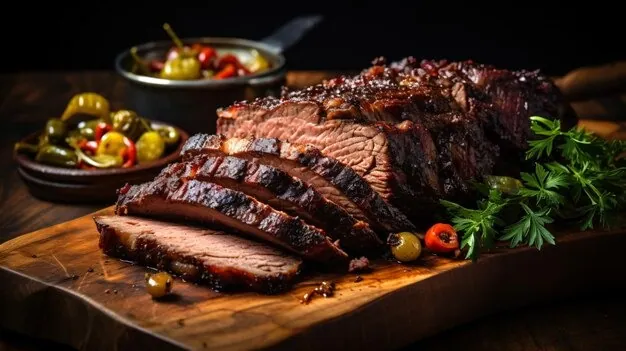
There’s nothing quite like sinking your teeth into a slice of fall-off-the-bone smoked brisket. As a lifelong barbecue enthusiast, I’ve come to appreciate the rich traditions behind the cuisines of Texas and beyond. None compare to the bold flavors of Texan smoked beef brisket, especially when prepared by a true pitmaster. Over my years behind the smoker, I’ve perfected the art of cooking a whole packer brisket to tender, smoky perfection. In this How to Smoke a 15 Pound Brisket Recipe, I’m sharing my tried-and-true method for achieving restaurant-quality results at home with your own 15-pound brisket.
Contents
- How to Smoke a 15 Pound Brisket
- How Long will it Take to Smoke a 15 Pound Brisket?
- What Type of Wood Should I Use to Smoke Brisket?
- What Temperature Should I Smoke a Brisket At?
- Should You Cook Brisket With Fat Side Up Or Down?
- Should I Wrap in Butcher Paper or Aluminum Foil?
- How to Smoke a Brisket on a Pellet Grill?
- How to Wrap a Brisket?
- How to Tell When Smoked Brisket Is Done?
- How Long Do You Rest a Brisket?
- How to Slice a Brisket?
- How Do You Know If You’ve Made a Good Brisket?
- Delicious Ways to Serve Your 15-Pound Brisket
- Tips For Smoking Brisket
- Burnt Ends
- What to do with Leftover Brisket?
- How to Reheat Brisket?
- Troubleshooting Common Brisket Problems
- Frequently Asked Questions (FAQs)
- 1. Should I smoke brisket at 180 or 225?
- 2. How long to smoke brisket at 225?
- 3. How long to cook a 15 lb brisket at 225?
- 4. How long does it take to smoke a 15lb brisket?
- 5. How many people will a 15 pound brisket feed?
- 6. How long to smoke 17 lb brisket at 225?
- 7. How long to rest a 15 lb brisket?
- 8. Is 4 hours too long to rest a brisket?
- 9. Can I rest my brisket overnight?
- 10. How do you keep brisket moist?
- 11. At what temp is brisket done?
- 12. Can you overcook brisket?
- How to Smoke a 15 Pound Brisket
How to Smoke a 15 Pound Brisket
In this recipe, I’ll walk you through my foolproof process for how to smoke a brisket and achieving pro-level results on a whole packer brisket. Just wait until your first bite of succulent, smoke-kissed meat hits your tongue. So let’s get started – it’s time to level up your barbecue game and join the ranks of true pitmasters!
Choosing the Right Brisket
Selecting the right cut of meat is an important first step when learning how to smoke a 15-pound brisket. For a large brisket like this 15 pounder, I like to use a whole packer brisket. The packer cut includes both the flat and pointed ends with a nice even thickness of fat throughout. This ensures the brisket will remain moist and juicy during the long, slow cook.
When buying a brisket, I always look for one that is vacuum sealed in a cryovac pack. Cryovac packaging helps keep the brisket fresh and allows me to see the thickness and distribution of fat. I prefer this to briskets previously opened. If none are cryovac packed, I’ll visit my local butcher since they are knowledgeable about selecting cuts for smoking, using their trimming procedure to ensure the perfect meat cut.
When selecting a 15-pound brisket, I make sure to check for good marbling and thickness. The average whole packer brisket weighs 12 to 16 pounds. A whole packer includes two distinct pieces – the flat and the point. The flat on one side is a lean, thin cut known as the brisket flat. On the opposite end is a thicker, fattier cut called the point. For beginners like myself just starting out with smoking, the point helps ensure the whole brisket cooks evenly and stays juicy.
Grades of a Brisket
When picking out a brisket, it’s important to take the opportunity to closely examine the meat and look for good marbling. Often, briskets are tightly wrapped, making it hard to determine the grade. The USDA uses a standard rating system, so consumers know upfront what grades of beef they are buying based on maturity. Generally speaking, there are four main grades from least to greatest: select, choice, prime, and Wagyu in that order from lowest to highest. Knowing how to smoke a 15 Pound Brisket is essential for achieving optimal results.
For a delicious smoked brisket, I never stop at anything less than choice grade when buying. Marbling provides a juicier end result. I want my smoked brisket to be juicy and flavorful. For those just starting, I recommend starting with select and working up as higher grades become available.
While the grade alone shouldn’t determine your brisket selection, marbling plays a key role in how juicy it remains. More experienced pitmasters may feel comfortable jumping to prime or Wagyu, but starting lower gives room to learn without risks.
Preparing Your Brisket For The Barbecue
Now that the ideal brisket has been selected based on grade and marbling, it’s time to properly prepare for how to smoke a 15 pound brisket. Bringing the beef directly home from the store, there are still a few key steps to chill and prepare the brisket before loading it for the long, slow smoked cook.


Chilling Your Brisket For Trimming (Optional)
When I’m preparing one of my smoked brisket recipes, I like to initially chill the brisket before trimming. I remove it from the grocery package and pat dry with paper towels to absorb excess moisture. Then I place it on a baking sheet and put it in my freezer for 30–45 minutes until it’s slightly cooled and firmed up for me to work with. I find this makes the trim process much easier for myself when the brisket is partially frozen. The short chilling helps me easily distinguish the lines of fat I want to cut away from the meat I’ll be leaving on for my smokey barbecue feast.
How to Trim a Brisket?
After trying different methods, I’ve found that chilling the beef brisket before trimming is the easiest thing I do to prepare it. Firming up the meat allows the lines of fat to better slide around underneath my knife rather than having it all stick together. This makes trimming much easier for myself to shape the flat and point. Some more seasoned pitmasters may wish to skip this extra step, but in the beginning I wish I had chilled to help distinguish all the layers. Now it’s just part of my regular brisket preparation process before a big summer cookout.
BBQ experts recommend trimming the brisket thoroughly before smoking for several key reasons:
- Trimming allows the smoke to flow more evenly throughout the entire brisket during the long cook.
- Removing unnecessary fat helps it render off cleanly during the cooking process for a cleaner finished product.
- Removing excess fat prevents it from directly blocking seasoning from exposing the meat so it seasons properly.
- Eliminating the uneven or unattractive edge creates a better looking finished product in the end.
Trimming takes some practice, but really helps ensure all the BBQ goodness gets throughout the whole cut equally come dinnertime.
Ingredients
For trimming the fat away from the top and side of my brisket, I like to have the proper tools ready:
- Very sharp knife – trimming a cold brisket requires a good blade to cut cleanly through all the layers of fat. I keep my trimming knife exclusively for meat prep.
- Cutting board – I chill my cutting board in the fridge alongside the brisket to keep everything cold under my knife.
- Paper towels (if you skipped the chilling step) – If I didn’t chill the brisket, I use these to wipe away excess moisture while trimming.
- Cold brisket – Makes the lines of fat adhere together better rather than sticking to the blade.
I also leave about a quarter inch or less of fat around the entire brisket, rather than removing it all. This outer cap will help render during the long, slow cook. Any trimmings get chilled for later use to render delicious tallow for cooking. Keeping a stationary chilled cutting board and brisket helps things stay in place underneath my knife while I trim.


Instructions
The amount of trimming varies by personal preference, but for me, it’s typically around two pounds removed from a whole packer brisket. Follow these step-by-step instructions to get it prepped for the smoked cooking process:
- Lay the brisket fat cap side facing up on the cutting board and pat dry with a paper towel. Inspect the side and solid fat layers and slightly trim any excess.
- Trim the thick fat cap evenly to leave about a 1/4-inch layer. I find this thickness renders nicely for moisture.
- Flip the brisket over and inspect the meaty part. Trim any remaining pockets of fat or silver skin, the thin membrane resembling connective tissue with its cloudy surface. Remove any hard fat that feels very firm to the touch. Look for any larger chunks of fat that may remain, as sometimes a pocket can be found where the flat and point connect. Carefully trim and expose more of the red meat surface that will best absorb the smoke, helping it to nicely turn a beautiful mahogany during the long cook. This also aids a nice seasoned bark to develop from the applied dry rub.
Seasoning your brisket
Once trimmed, it’s time to properly season the brisket before smoking. The type of rub I choose often depends on what I’m feeling like – some days call for a savory combination, while others a spicy one. I enjoy experimenting to see what new flavors I can cook up!
Both pre-made and homemade beef rubs work well. One of my favorites is a simple combo of salt, pepper, garlic powder, onion powder, and a bit of brown sugar. This last ingredient helps with caramelization during the long cook.
For seasoning, I generously apply a good amount of salt and black pepper. As a large cut of meat, the brisket can really hold up to flavor without being afraid of using too much. I like to cover all sides. Some binders like olive oil or yellow mustard help the rub stick if you need to be, but usually the fat content is sufficient.
Additional Tips and Technique
It’s important to keep a few things in mind when seasoning the brisket.
- For best flavor penetration, allow time for the generous application of rub to set by wrapping and refrigerating the brisket for 12 to 24 hours. This step really enhances the smokey flavor.
- Don’t be concerned if the brisket’s outer layer looks a bit rough and charred coming out of the smoker – this is commonly called the bark and often resembles the bark on a tree. It adds tremendous texture and savory flavor to each moist, smoky bite.
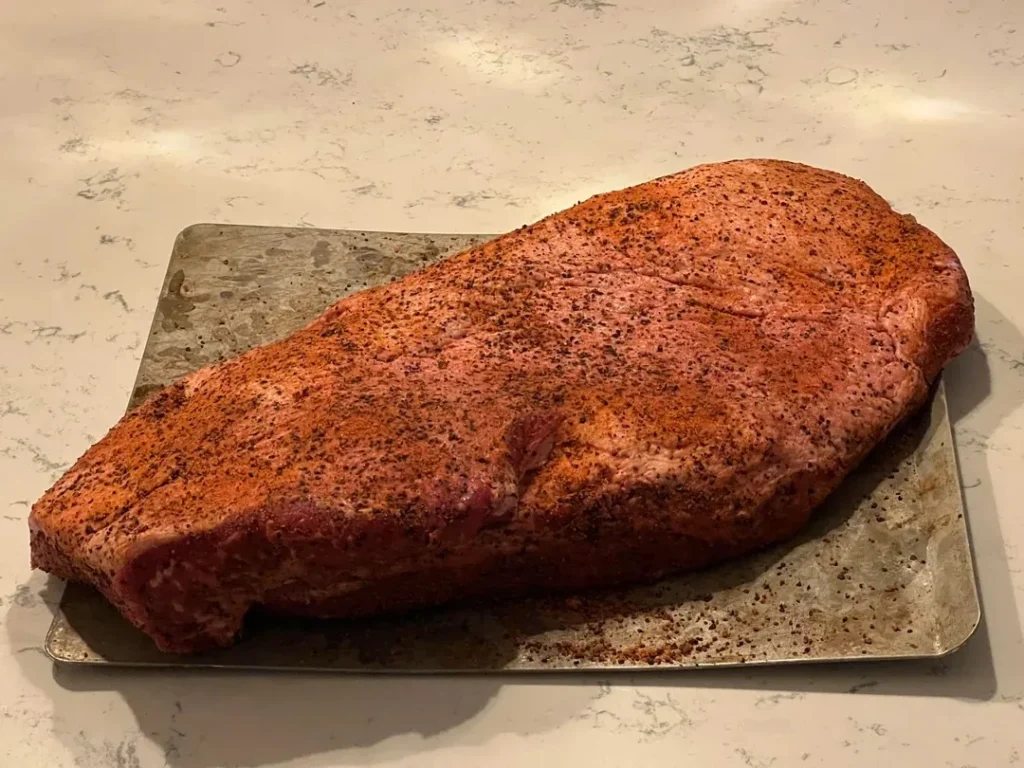

Seasoning takes the brisket to the next level, so I’m always generous and patient with allowing time for those seasonings to infuse before smoking.
Enhancing Brisket Flavor with Rubs
- For a classic beefy taste, my go-to combination is kosher salt, black pepper and a pre-made Texas-style brisket rub. The blend of spices is hard to beat in my opinion.
- Other times I may want more flavor complexity and decide to add some touch of my homemade Dalmatian rub, including garlic and onion powder.
- Many store-bought rubs also offer good options featuring key ingredients like brown sugar, paprika, or even some jalapeño powder for a kick.
The best way is to suggest trying out different rubs over successive smokes so you and your family can decide on a favorite. While it may seem difficult at first with many options, I instruct applying only a light, even layer to allow for optimal smoke penetration without overindulging in spices that could overwhelm the brisket’s natural beef and smoky flavor.
How Long will it Take to Smoke a 15 Pound Brisket?
Figuring out how long to smoke a brisket is part science, part art. Using a general estimate of 1 hour per pound can provide a good guide for planning the cooking time. It’s always best to invest in a good quality meat thermometer and cook it to the correct internal temperature so it’s properly cooked. Once the thickest part of the flat reaches around 200°F, start checking it frequently. The final say is when an inserted probe should glide in smoothly like butter with just a little resistance.
- For a 10 lb brisket, plan to smoke for around 6–9 hours total, allowing it to rest for at least 1 hour before serving.
- A standard 15 lb packer brisket will likely require 10–12 hours in the smoke, followed by the same resting period of at least 1 hour.
- A larger whole brisket weighing about 20 lbs may need 12–16 hours total in the smoker. Again, rest for a minimum of 1 hour.
It’s always best to give the meat enough time – “good things come to those who wait”! Rest assured, your patience will be rewarded. I’m glad to provide these guidelines to achieve perfect tenderness.
What Type of Wood Should I Use to Smoke Brisket?
With brisket being such a big piece of meat, it can really stand up to more robust smoke flavors. If you want to learn how to smoke a 15 pound brisket, choosing the right wood is crucial. Some top smoking woods commonly mentioned include hickory, which imparts a very bold, savory flavor. I sometimes like to mix it with a milder wood like oak to help balance things out. Certain fruit woods like apple or cherry can also lend a subtle sweetness to smoke flavors.
If looking for a safe bet, a classic smoked brisket pairs beautifully with tried and true hickory. But I also enjoy getting creative – have you considered pecan wood? The hint of nutty flavor it contributes truly adds a whole new layer of depth, especially when paired with sweet or spicy flavors. And don’t overlook how cherry wood can further sweeten the profile.
Some of my Texas friends also swear by oak. While it may lack boldness, the mild smoke perfectly pairs with certain rubs. So in summary, feel free to experiment – most hardwoods make a great choice, except bad choices like pine which can impart an unpleasant chemical flavor.
What Temperature Should I Smoke a Brisket At?
Maintaining a temperature between 225-250°F is crucial for achieving the perfect smoked brisket, including how to smoke a 15 pound brisket. Cooking at this low temperature allows the fat to slowly render and the connective tissue to break down before it can tighten up, resulting in meat that is moist and tender rather than tough and chewy.
This gradual approach gives the brisket time to absorb smoke flavor over many hours as it cooks, preventing the meat from drying out. Any hotter or more fast of a cook could cause the connective tissue to tighten up, leaving the meat tough and chewy. Sticking to 225-250°F is the proven method for ensuring a juicy, flavorful brisket.
Should You Cook Brisket With Fat Side Up Or Down?
When it comes to cooking a brisket, most experts recommend laying it fat side down for a few key reasons.
- Better flavor: As the fat slowly melts and drips down, it bastes the meat and helps that flavorful bark or cap to really form and wash away any seasoning. This also helps make the already tender brisket meat even more succulent.
- Better presentation: While it cooks fat side down, it allows you to easily serve or slice the presentation side once removed from the grill grates. Nothing is more beautiful than lifting the lid to find a gorgeously bark-formed brisket waiting.
So in summary, I recommend getting the most flavor and tenderness internally by cooking your brisket fat side down if possible for a true backyard barbecued delight!
Should I Wrap in Butcher Paper or Aluminum Foil?
One commonly used method to help speed up the sometimes tedious cooking process is wrapping the brisket during the stall period to prevent or lessen excessive moisture evaporation from the surface that often halts or slows cooking. Both foil and butcher paper are commonly used for this step.
While wrapping in foil will indeed speed things along by basically steaming the remainder of the cook, it can often ruin that coveted bark and leave more of a pot roast-like taste. In my experience, wrapping with butcher paper allows the meat to still breathe, so it finishes cooking with a beautifully intact bark.
For the best result, I’d recommend opting for butcher paper when wrapping, versus foil, to maintain the most authentic smoked brisket flavor and presentation. It’s well worth the extra hour or two for that perfect crust!
How to Smoke a Brisket on a Pellet Grill?
Wondering how to smoke a 15 pound brisket on a pellet grill? Before diving into the instructions, ensure you’ve got the basics down – from temperature control to selecting the right wood pellets.
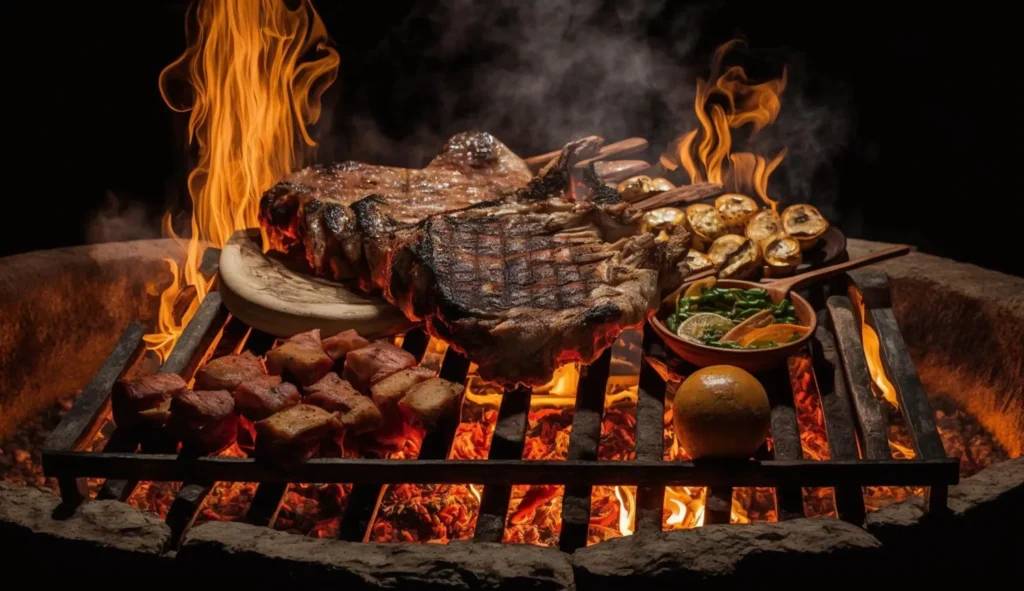

- I remove the full packer brisket from its store packaging and begin the trimming process, removing excess fat and the thick layer of silver skin from the top of the brisket, leaving about a 1/4 inch of fat on the bottom.
- I prefer to season the brisket the night before smoking to allow the generous seasoning more time to fully penetrate into the moist meat.
- I season the brisket liberally with my favorite beef rub. Some great simple options are a mix of kosher salt, coarse black pepper, and granulated garlic.
- I cover the meat and apply the dry rub generously but don’t get too shy with it.
- If not smoking overnight, I allow the brisket to sit nicely wrapped in plastic wrap in the refrigerator for as long as 4–6 hours before placing it onto the smoker.
- I’ll be using my trusty Pit Boss pellet smoker fueled by hickory pellets which always produces fine deliciously smoky results. Smoke the brisket at 225-250°F fat side down for the first 3–4 hours, not opening the lid.
- I spritz the brisket with apple cider vinegar or water anytime it looks dried out, continuing every 45 minutes to an hour.
- Once the internal temperature of the brisket reaches 165°F or more, it’s time to wrap it in butcher paper until fully bark is set.
How to Wrap a Brisket?
Most pitmasters recommend wrapping the brisket once the internal temperature of the meat reaches 165–170 degrees. However, I often like to wait until it hits 175-180°F to make sure the coveted bark has really set before wrapping.
Once ready, wrap the brisket tightly in a double layer of butcher paper to seal in moisture. I’ve found using this breathable, porous material works best versus other options that could steam the meat. Feel free to use aluminum foil as well if that’s all you have, but butcher paper allows the meat to still breathe a bit.
Secure the wrap with a little tape and then place the wrapped brisket back in the smoker to let the cook time continue until reaching tender 203°F internally. The paper wrap will speed things up from this point in the cook while still yielding moist, tender results.
RELATED: Smoked French Onion Soup
RELATED: Smoked Pork Belly Pinwheels
How to Tell When Smoked Brisket Is Done?
As an experienced backyard pitmaster, mastering how to smoke a 15 pound brisket is a journey. The simplest way for me to know when my home smoked brisket is fully done is to simply insert my trusty instant-read probe. The probe should slide into the flat or point section with similar ease as room temperature butter, which usually happens right around 200-205°F for me.
In addition to the reading, the probe should easily insert into the moist meat with just a slight tug, just like butter. If it does not slide in smoothly, then I give the brisket a bit more time in the smoker, despite what the temperature reading says.
For the absolute best results, I’ve learned it pays to become familiar with what my finished brisket looks and feels like when poked with a gloved finger. That first one didn’t mean much, but now a year later I truly know the ideal color, texture and how the generous size and shape of the finished brisket bounces back when touched. If it still resists slightly, it likely needs just a bit longer time in my trusty Offset pit to achieve succulent perfection.
How Long Do You Rest a Brisket?
As an avid backyard pitmaster, the question of how long to rest a brisket is incredibly crucial to me. I always recommend allowing for a minimum rest of one hour, but prefer to rest mine up to six hours if my schedule allows. Once my brisket reaches an internal temperature of around 200°F in the thickest part of the flat, it’s time for it to rest.
I allow the brisket to cool off for about 10 minutes before loosely wrapping it in a towel or butcher paper. Then I place the wrapped brisket in an empty cooler and shut the lid. I allow it to rest at least an hour, preferably two to three hours, so the residual connective tissue can fully break down. Remarkably, my brisket is still warm even after this long rest.
The old barbecue pros know this step is arguably one of the most important things to get tender, moist results. It results in a brisket that beautifully drapes off my own outstretched finger. Additionally, the juices have time to evenly distribute throughout before I start slicing. Otherwise, I’d lose plenty of that delicious juiciness all over my kitchen floor!
How to Slice a Brisket?
It’s important to always slice the brisket against the grain for the tenderest bite and best mouthfeel. As a barbecue lover, cutting with the grain would be disappointing, since it can make even a perfectly cooked brisket chewy. I always take care to slice the flat very thinly against the grain and continue until I get to where the flat meets the delicious brisket point.
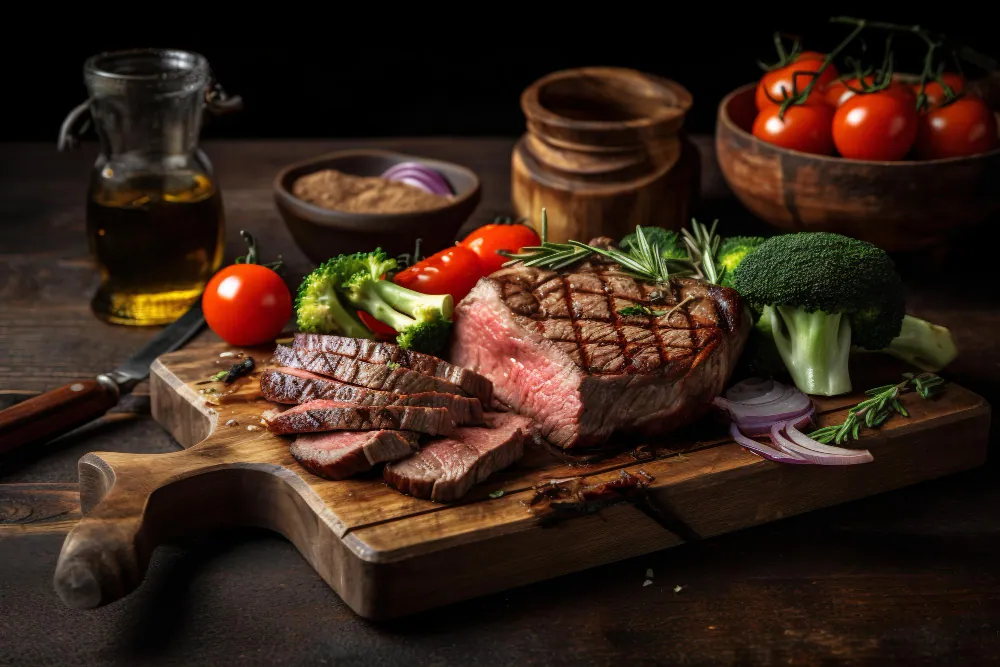

Then I carefully turn the brisket point 90 degrees to allow easy cutting of those flavorful slices against its grain, which runs in a different direction than the grain of the tender flat. Any ends and oddly miscut pieces are perfect for my favorite burnt ends. With years of smoking experience, I now keep in mind the subtle yet important grain running variations of the point versus the flat to yield supremely tender and juicy results.
How Do You Know If You’ve Made a Good Brisket?
There are a few simple ways to know if a brisket has been cooked well.
Bend test – can the finished brisket bend with ease and hang over an outstretched finger without the knife?
Hang test – does the entire brisket stay together under its own weight or fall apart into individual slices?
Pull apart test – when gently tugging on opposite ends of a slice, does the brisket easily pull apart and stretch without tearing into chunks?
If the brisket passes all three of these basic tests, then one knows it has achieved the ultimate tenderness and moisture – a true sign of success for any pitmaster!
Delicious Ways to Serve Your 15-Pound Brisket
Be it served sliced, chopped, burnt ends, brisket chili or brisket hash; one thing about this is that many recipes call for slow smoked beef brisket.
Sliced: Slice the brisket thin against the grain and place on a platter with your favorite barbecue sauce.
Chopped: It’s perfect for sandwiches, tacos or nachos. Mix it with your favorite BBQ sauce to add more flavor to it.
Burnt Ends: You will have delicious burnt ends if you separated the point. Dice them and put them in your favorite BBQ sauce; they become a sweet and savory treat.
Brisket Chili: Make a hearty chili using left over brisket. It’s also a good way of using leftovers and getting warm on cold days
Brisket Hash: This is delicious for breakfast or brunch dish. You can combine chopped pieces of briskets with potatoes, onions, and peppers
Brisket Tacos: Some toppings on warm tortillas like chopped briskets and drizzle some barbeque sauce over them.
Tips For Smoking Brisket
Before diving into how to smoke a 15 Pound Brisket, there are a few key tips to keep in mind:
- It’s always recommended to purchase a full packer brisket with both the point and flat still intact. Ask the butcher to make sure the brisket passes the bend test before buying.
- Use the fold/bend test to ensure tender meat when buying the fatty ends of the brisket.
- Butcher Knowledge is invaluable when buying a whole packer brisket.
- A sharp, 14-inch knife makes for easy, precise trimming.
- The knife should be sharp, and you’re comfortable with its weight in-hand.
- A colder brisket is easier to accurately and cleanly trim.
- Always slice across the grain of the meat for maximum tenderness.
- Save any pieces that can be used for carne asada tacos.
- Carefully trim the thick fat cap on the bottom to just a quarter to half inch of fat.
- Bevel the edges of the brisket to prevent fraying, as the fatty edges can get dry during the long cook.
- For even cooking, cook the brisket fat side down on the smoker grates.
- Save the flavorful brisket drippings for making au jus or a tasty dipping sauce.
- Plan to save the drippings to later use on the bottom or fat side of the brisket before serving.
- Go lighter on the salt in standard rubs, since brisket is such a fatty cut of meat.
Burnt Ends
Proper preparation is crucial to achieving moist, tender smoked brisket. I start with a full packer brisket cut containing two distinct parts that cook differently. The point is more marbled with fat, while the flat is leaner. Common seasoning blends like kosher salt and coarse black pepper are liberally applied the day before smoke to allow the flavors to penetrate the meat. I perform a bend test to ensure tenderness – the brisket should sag gently. Smoke at 225-250°F, fat side down. Occasional spritzing with apple cider vinegar keeps it from drying out.


Once the internal temperature reaches 165°F, I wrap in butcher paper to help it turn succulent and fork tender. The point really shines when made into my favorite smoky snack – burnt ends. True meat candy. I separate it from the flat and cut it into 1-inch cubes. In a small bowl, I whisk together 2 cups of beef broth and 12oz of my homemade BBQ sauce before placing the tender cubes in a metal pan to gently toss. At 250°F, an additional hour brings out deep flavor through the prized Maillard reaction. Pulling the fall-off-the-bone rich and caramelized bites makes all the low and slow worth it. Plates are always licked clean of this BBQ deliciousness!
What to do with Leftover Brisket?
While nothing quite compares to freshly smoked brisket, there are several creative ways for me to enjoy any leftovers. I love mixing shredded brisket into my homemade brisket jam for an incredible sandwich spread. It’s also the ultimate burger topper, taking any plain patty to a whole new level of smoky goodness. Sliders made with leftover brisket meat are always a tasty option too. For a heartier meal, nothing beats a rich brisket chili on a cold day. And a melty brisket grilled cheese is a guaranteed crowd-pleaser. To enjoy my handiwork later, I will sometimes vacuum seal and freeze any extra brisket for up to 6 months.
How to Reheat Brisket?
When I have a good amount of brisket leftovers, it means plenty of creative ways to continue enjoying this smoky delight even off the grill. To reheat while preserving the same flavor that made it so irresistible originally, I cook it covered with foil in a shallow drip pan. Once warmed through and the internal temperature reaches 140 degrees, it’s ready to serve.
For variety, I sometimes mix up the wood pellets in my smoker to impart a different smoke experience. An optional splash of BBQ sauce, beer, or beef broth in the pan before cooking also infuses new dimensions. However, it’s prepared, smoked brisket remains a true taste of barbecue happiness worth savoring time and again.
Troubleshooting Common Brisket Problems
This article highlights several challenges to be faced in smoking a large brisket. But there are a number of things that can be done to solve these challenges:
- Brisket Stalling: Some pitmasters refer to it as “the stall,” which is the time when the temperature of the meat plateaus for hours. This happens due to evaporative cooling.
Solution: Use butcher paper or foil around the brisket to maintain moisture and heat, thereby assisting you in getting through the stall.
- Dry Brisket: One may end up with dry meat if they overcook it or cook at high temperatures.
Solution: Employ an internal thermometer for monitoring purposes during cooking. The brisket should be wrapped around 165°F (74°C) and cooked until it hits 200-205°F (93-96°C). Let your smoked beef rest for at least one hour before slicing into it so that its juices can redistribute properly.
- Tough Brisket: A poorly marbled selection or undercooking may lead to a tough texture.
Solution: Ensure that your cut is cooked until internal temperatures range between 200-205°F (93-96°C), slice against grain so that you obtain maximum tenderness.
- Burnt Ends: If you find that the point end of your brisket is too dark, then you might have overcooked it.
Solution: When wrapping separate both pieces. By doing so, you will be able to control how it cooks, since generally the point gets ready quickly enough.
- Uneven Cooking: This can happen if your smoker has hot spots or if your brisket is unevenly trimmed.
Solution: Rotate the brisket during the cook and ensure your smoker maintains a consistent temperature.
Conclusion
How to Smoke a 15 Pound Brisket? Smoked brisket is a cut of meat worthy of the utmost care and patience during the long cooking process. For those willing to master low-and-slow smoking techniques, the melt-in-your-mouth rewards make all the effort worthwhile. With a few tried and true tips, even beginners can achieve restaurant-quality results to be proud of. Most importantly, enjoying barbecue brings people together – and what could be better than that?
Frequently Asked Questions (FAQs)
1. Should I smoke brisket at 180 or 225?
Most pitmasters recommend smoking brisket between 225-250°F, as this allows the fat and connective tissue to slowly break down, resulting in moist, tender meat. Some experts experiment with lower temperatures around 180°F for ultra-slow cooking. However, 225-250°F is proven to give great brisket by allowing slow absorption of smoke flavor over many hours, without the risk of drying out or toughening the meat.
2. How long to smoke brisket at 225?
As a general guideline, here are recommendations for how to smoke a 15 pound brisket at 225:
- Small 5-8 lb brisket: 8–12 hours at 225°F
- Medium 9-12 lb brisket: 10–16 hours at 225°F
- Large 13-16 lb brisket: 14–18 hours at 225°F
- Extra large 17+ lb brisket: 16–22 hours at 225°F
3. How long to cook a 15 lb brisket at 225?
A 15 lb brisket will generally require 14–18 hours of smoking at 225°F, using an internal temp of 195-203°F as an indicator of doneness, to accurately determine how long to cook it.
4. How long does it take to smoke a 15lb brisket?
A 15lb brisket is a sizable cut that requires low and slow cooking. Plan for 14-18 hours of smoking at 225°F to properly tenderize it.
5. How many people will a 15 pound brisket feed?
A 15lb brisket yields a generous amount of meat once sliced. Expect it to comfortably serve 15-20 people depending on portion sizes.
6. How long to smoke 17 lb brisket at 225?
Smoking a 17lb brisket is a time commitment. Anticipate 16-20 hours at 225°F, starting checks at the 14 hour mark.
7. How long to rest a 15 lb brisket?
After smoking a 15lb brisket to 195-203°F, allow ample time for juices to resettle. Minimum 1 hour resting completes the cooking process.
8. Is 4 hours too long to rest a brisket?
While resting fosters tenderness, extended resting isn’t required. 1-2 hours is adequate, as lengthy resting won’t improve quality.
9. Can I rest my brisket overnight?
Resting overnight in the refrigerator is acceptable, though shorter resting at room temp yields juicier results. Seal well to prevent drying out.
10. How do you keep brisket moist?
Use a spray or water pan to introduce humidity during smoke. Wrap in foil or paper once temp reaches 160°F to brake down connective tissue.
11. At what temp is brisket done?
Check for tenderness, not just temperature. 195°F internal temp in thickest part signifies rendering is underway. 203°F confirms it’s fully tender.
12. Can you overcook brisket?
Brisket has a wide window, but prolonged cooking post-tenderness will dry it out. Don’t linger past temp range or tenderness test; pull from heat when probing meets no resistance.
How to Smoke a 15 Pound Brisket
Course: Smoked CuisineCuisine: American4
servings1
hour15
hours650
kcal16
hoursThis smoked brisket elevates backyard barbecue with melt-in-your-mouth tender meat lent extraordinary depth from a day smoking over oak. Generously marbled and seasoned overnight, its intense savoriness enriched further during the long cooking process. Every succulent slice offers a seamlessly blended medley of smoky and tender brisket perfection.
Ingredients
15 pound whole packer brisket
4 tablespoons of beef seasoning or homemade beef rub
2 tablespoons yellow mustard or olive oil (optional binder)
Directions
- Remove brisket from packaging and pat dry with paper towels.
- Place brisket on a chilled cutting board and trim away excess fat, leaving about 1/4 inch layer.
- Flip brisket and trim off any thick silverskin if needed.
- Generously season all surfaces of brisket with rub of choice (kosher salt, black pepper, garlic powder or a pre-made beef rub).
- Place brisket back on cutting board and refrigerate for 12-24 hours to allow seasoning to penetrate the meat.
- Smoke brisket fat side down at 225-250°F for the first 3-4 hours without opening smoker lid.
- Spritz brisket with apple cider vinegar every 45-60 minutes to prevent drying out.
- Once brisket reaches an internal temp of 165°F, wrap tightly in butcher paper.
- Continue smoking brisket until it reaches 203°F internal temp.
- Check for knife-tender texture throughout when probing with a sharp knife.
- Allow brisket to rest 1-6 hours before slicing against the grain into thin slices.

